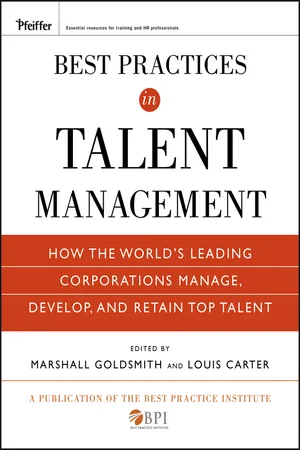
Best Practices in Talent Management
How the World's Leading Corporations Manage, Develop, and Retain Top Talent
Marshall Goldsmith, Louis Carter
- English
- ePUB (mobile friendly)
- Available on iOS & Android
Best Practices in Talent Management
How the World's Leading Corporations Manage, Develop, and Retain Top Talent
Marshall Goldsmith, Louis Carter
About This Book
Praise for BEST PRACTICES in TALENT MANAGEMENT
"This book includes the most up-to-date thinking, tools, models, instruments and case studies necessary to identify, lead, and manage talent within your organization and with a focus on results. It provides it all—from thought leadership to real-world practice."
PATRICK CARMICHAEL
HEAD OF TALENT MANAGEMENT, REFINING, MARKETING, AND INTERNATIONAL OPERATIONS, SAUDI ARAMCO
"This is a superb compendium of stories that give the reader a peek behind the curtains of top notch organizations who have wrestled with current issues of talent management. Their lessons learned are vital for leaders and practitioners who want a very valuable heads up."
BEVERLY KAYE
FOUNDER/CEO: CAREER SYSTEMS INTERNATIONAL AND CO-AUTHOR, LOVE 'EM OR LOSE 'EM
"This is a must read for organization leaders and HR practitioners who cope with the today's most critical business challenge—talent management. This book provides a vast amount of thought provoking ideals, tools, and models, for building and implementing talent management strategies. I highly recommend it!"
DALE HALM
ORGANIZATION DEVELOPMENT PROGRAM MANAGER, ARIZONA PUBLIC SERVICE
"If you are responsible for planning and implementing an effective talent and succession management strategy in your organization, this book provides the case study examples you are looking for."
DORIS SIMS
AUTHOR, BUILDING TOMORROW'S TALENT
"A must read for all managers who wish to implement a best practice talent management program within their organization"
FARIBORZ GHADAR WILLIAM A. SCHREYER PROFESSOR OF GLOBAL MANAGEMENT, POLICIES AND PLANNING SENIOR ADVISOR AND DISTINGUISHED SENIOR SCHOLAR CENTER FOR STRATEGIC AND INTERNATIONAL AFFAIRS FOUNDING DIRECTOR CENTER FOR GLOBAL BUSINESS STUDIES
Frequently asked questions
CHAPTER 1
AVON PRODUCTS, INC.
- Introduction
- A Success-Driven Challenge
- The Turnaround
- The Talent Challenge
- Execute on the “What,” Differentiate with “How”
- From Opaque to Transparent
- The Avon 360
- Broad-Based Transparency
- From Complex to Simple
- Performance Management
- Engagement Survey
- From Egalitarian to Differentiated
- Communication to Leadership Teams
- A Few Big Bets
- Tools and Processes
- From Episodic to Disciplined
- From Emotional to Factual
- From Meaningless to Consequential
- The Results of a Talent Turnaround
- Measuring the Talent Turnaround’s Success
INTRODUCTION
A SUCCESS-DRIVEN CHALLENGE
THE TURNAROUND
- Moving from a Regional to a Matrix Structure: Geographic regions that had operated with significant latitude were now matrixed with global business functions, including Marketing and Supply Chain.
- Delayering: A systematic, six-month process was started to take the organization from fifteen layers of management to eight, including a compensation and benefit reduction of up to 25 percent.
- Significant Investment in Executive Talent: Of the CEO’s fourteen direct reports, six key roles were replaced externally from 2004 to 2006, including the CFO, head of North America, head of Latin America, and the leaders of Human Resources, Marketing, and Strategy. Five of her other direct reports were in new roles.
- New Capabilities Were Created: A major effort to source Brand Management, Marketing Analytics, and Supply Chain capabilities was launched, which brought hundreds of new leaders into Avon.
THE TALENT CHALLENGE
- Opaque: Neither managers nor Associates knew how existing talent practices (that is, performance management, succession planning) worked or what they were intended to do. To the average employee, these processes were a black box.
- Egalitarian: While the Avon culture reinforced treating every Associate well, this behavior had morphed into treating every Associate in the same way. High performers weren’t enjoying a fundamentally different work experience and low performers weren’t being managed effectively.
- Complex: The performance management form was ten pages long, and the succession planning process required a full-time employee just to manage the data and assemble thick black binders of information for twice-yearly reviews. Complexity existed without commensurate value, and the effectiveness rate of the talent practices was low.
- Episodic: Employee surveys, talent reviews, development planning, and succession planning, when done at all, were done at a frequency determined by individual managers around the world.
- Emotional: Decisions on talent movement, promotions, and other key talent activities were often influenced as much by individual knowledge and emotion as by objective facts.
- Meaningless: No talent practice had “teeth.” HR couldn’t answer the most basic question a manager might ask about talent practices—“What will happen to me if I don’t do this?”
EXECUTE ON THE “WHAT,” DIFFERENTIATE WITH “HOW”
- Execute on the “what.” The Top Companies for Leaders study found that simple, well-executed talent practices dominated at companies that consistently produced great earnings and great leaders. We similarly believed that fundamental talent practices (that is, performance management or succession planning) would deliver the expected results if they were consistently and flawlessly executed. We decided to build talent practices that were easy to implement and a talent management structure that would ensure they were consistently and flawlessly implemented. More importantly, we decided to . . .
- Differentiate on “how.” While disciplined execution could create a strong foundation for success, the six adjectives that described Avon’s current processes were largely responsible for their failure. We drew inspiration from Marshall Goldsmith’s revolutionary recreation of the executive coaching process. He had taken a staid, academic/therapy model for improving leaders and turned it into a simple but powerful process that was proven effective in changing leaders’ behaviors.